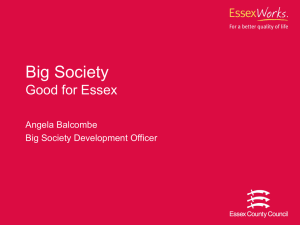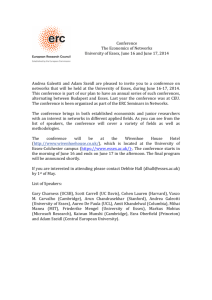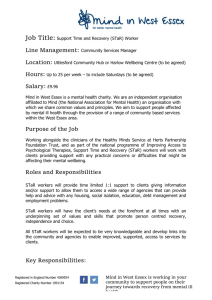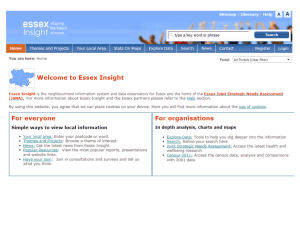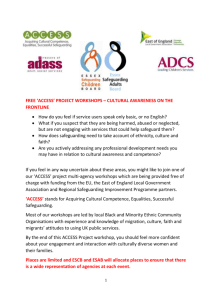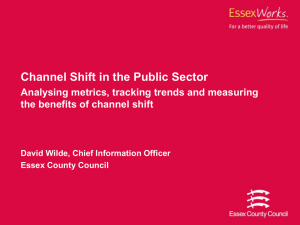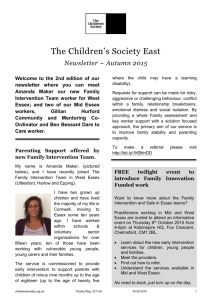TI1 Relationship based social work practice
advertisement
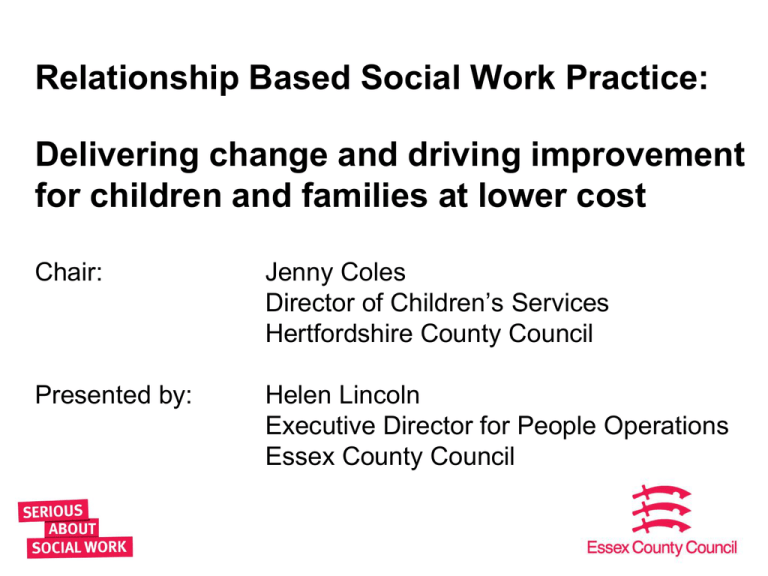
Relationship Based Social Work Practice: Delivering change and driving improvement for children and families at lower cost Chair: Jenny Coles Director of Children’s Services Hertfordshire County Council Presented by: Helen Lincoln Executive Director for People Operations Essex County Council Some Essex Context Year end 2011 Year end 2014 Contacts 55,240 51,930 Referrals 17,610 12,739 Children in Need 9,248 6,412 903 421 1,608 1,140 45 110 Child Protection Plans Children in Care Children Adopted 2014 – Ofsted rated ‘Good’ Mapping Deprivation in Essex Least Deprived Green Most Deprived Red A unifying use of theoretical models of evidence-based social work practice Small enough teams to allow team managers to know both staff & families well A whole systems approach to strategic planning & service delivery An operational culture of dialogue, reflective thinking, feedback, learning & support Workers with Service design which manageable minimises the number workloads that are of changes to regularly key reviewed worker/ transfers between teams Conditions for Success Appropriate practical support Articulating Values and Vision An aspirant & system-wide approach to improvement & performance A relentless focus on the recruitment, development and retention Wellbeing Effective Support Windscreen • 5 Bullet here Despite everything that happens around it “social work will always begin and end with a human encounter between two or more people and this encounter, or relationship as it develops, is the medium through which the social work task is carried out” Danielle Turney, University of Bristol ‘Relationship Based Social Work: getting to the heart of practice’ 6 Relationship Based Practice • Beginning; middle; end • Working with families amidst crisis and uncertainty, tolerating uncertainty • Seize the energy of crisis as a powerful change force • It has a coherent theoretical grounding, not ignoring intuition but not dictated by it • Relies on understanding family narratives, understanding how past experience affects current attitude and behaviour and how you work to change both • Facilitates an environment for workers to be skilled and confident in their ability to confront, challenge and resolve • Powerful approach for workers and they need the right support to anchor it 7 Modern relationship based practice approach curriculum Training / tools Strength based approaches Signs of safety Solution focused CBT Brief intervention Systemic approaches Motivational interviewing Applying these intelligently 8 9 QUESTION ONE Talk to the people sitting near you: Are you clear about the social work methodology promoted in your organisations? VOTING From your discussion what did you conclude? Should local authorities have an identifiable methodology to its social work practice? YES 11 NO Essex Promotion of a Relationship Based Approach • We have invested time, attention and energy to how social workers spend their time, mode of operating and how frontline managers support this • We are researching the significance of emotional intelligence to this approach • The thing that is common to all social workers is the world of the home visit... • How often do we unpick this? 12 The Practice Cycle: The Intimate/Flowing Pattern Engaged well with mother’s boyfriend and fixed an appointment to see him on his own. Agency of Friends SW moved around the home, inspecting & engaging with every room & possessions. The home was in a chaotic, dirty state, including dog faeces in bedrooms. Used different rooms to see the children, boyfriend & mother. SW not only checked all rooms but dwelled in them for whatever time was needed. Overcame the home. Agency of the parents/ carers SW used her skills & humanity positively & authoritatively to get beyond mother’s resistance. Gained entry into intimate spaces other workers had previously been denied access to. Slide from Prof. HARRY FERGUSON Set off with clear purpose & emotionally attuned CP mindset. Social worker’s Agency Began establishing relationship to assess whether risk or resource. Agency of the Home Well organised. Case records up to date. Good supervision. Made time to read the case history, had clear plan for visit. Child-centred, mobile, authoritative, playful, tactile, nurturing, confident & courageous. Deeply reflexive, spontaneous. Skilful communication, multi-tasking. Inspires engagement. Agency of the Agency SW integrating bureaucratic self & emotionally attuned way of being. Overcame mother’s resistance by being firm, clear, kind & child centred. Interacted with children immediately, skilfully & intuitively. Agency of the Children The children engaged in a disorganised manner. SW used voice, touch, movement, enthusiasm to establish rapport, trustworthiness & therapeutic impact. Overcame the dog, not allowing it to block the flow of the work. Arrived on doorstep in resilient state of mind & being. Agency of dogs and other pets Did not allow the barking dog to derail her and it calmed and ceased to be an issue. Agency of the Car Agency Place, Streets and Doorsteps Used car space to tune into herself & manage anxieties about relating to the service users, home. It was dark, no obvious threats on the streets. On doorstep dog heard barking ferociously inside. Mother answered door, 5 year old boy leapt into arms of SW, who welcomed it & walked in, carrying him. Empathy and Client Resistance and Disclosure Slide from Prof. DONALD FORRESTER Supervision Is it an emotionally informed thinking space? How does it support active, brave, risk sensible practice? Practice + Challenge + Feedback 15 “Towards Positions of Safe Uncertainty” Barry Mason (2008) SAFE Alternate care Supervised contact Evidence-based intervention Working agreement Multiple hypothesis Multiple points of intervention Context, belief, behaviour Multiple types of intervention Both/ and – risk/protective CERTAINTY Unallocated cases Avoidance and inconsistent engagement Not engaging further Missed visits Performance indicators Written agreements No further police reports Passive compliance 16 UNSAFE QUESTION TWO Talk to the people sitting near you: How do social workers in your authority become good? Do you create environment for social work practice to work well ? VOTING From your discussion what did you conclude? Do you think your organisation facilitates Social work to flourish ? YES 18 NO Impact in Essex on Taking a Relationship Based Approach Practice • Reduction of children in care • Reduction in children subject to child protection plans • Reduction in caseload better quality of work Cost • Reduced Reinvestment and savings • Early help • Targeted intervention • Intensive support 19 Number of Children in Care 2010/11 1,608 2011/12 1,499 2012/13 1,257 2013/14 1,140 A placement strategy has been developed and is reviewed and updated for budget monitoring purposes and setting the medium term resource strategy. The table below gives an analysis of the historical spend. Internal Foster Placements External Placements (Foster & Residential) SGO's / RO's / Staying Put/ Supported Living Internal Homes Total 20 2010/11 £m 12.18 31.01 1.59 7.83 52.61 2011/12 £m 13.63 30.22 5.14 6.53 55.52 2012/13 £m 12.76 23.61 5.79 1.91 44.07 2013/14 £m 12.14 20.61 6.60 1.76 41.11 21 22 QUESTION three Talk to the people sitting near you: What are the values of the service you provide? How do these values inform the decisions around taking children into and keeping children in care? Who in your authority prescribes the use of care? Social Workers? Schools? Health professionals? Police? Legal service? VOTING From your discussion what did you conclude? Do you think nationally we have the right children in care? YES 24 NO Relationship Based Partnership Work • Relationship based social work isn’t only about the direct relationship between the social worker and child/family. • Also significant are the relationships within and external to the organisation. • Confident, mature, partnerships on the ground mark a distinction between a fragile system and a strong sustainable system Questions/Discussions? 26
